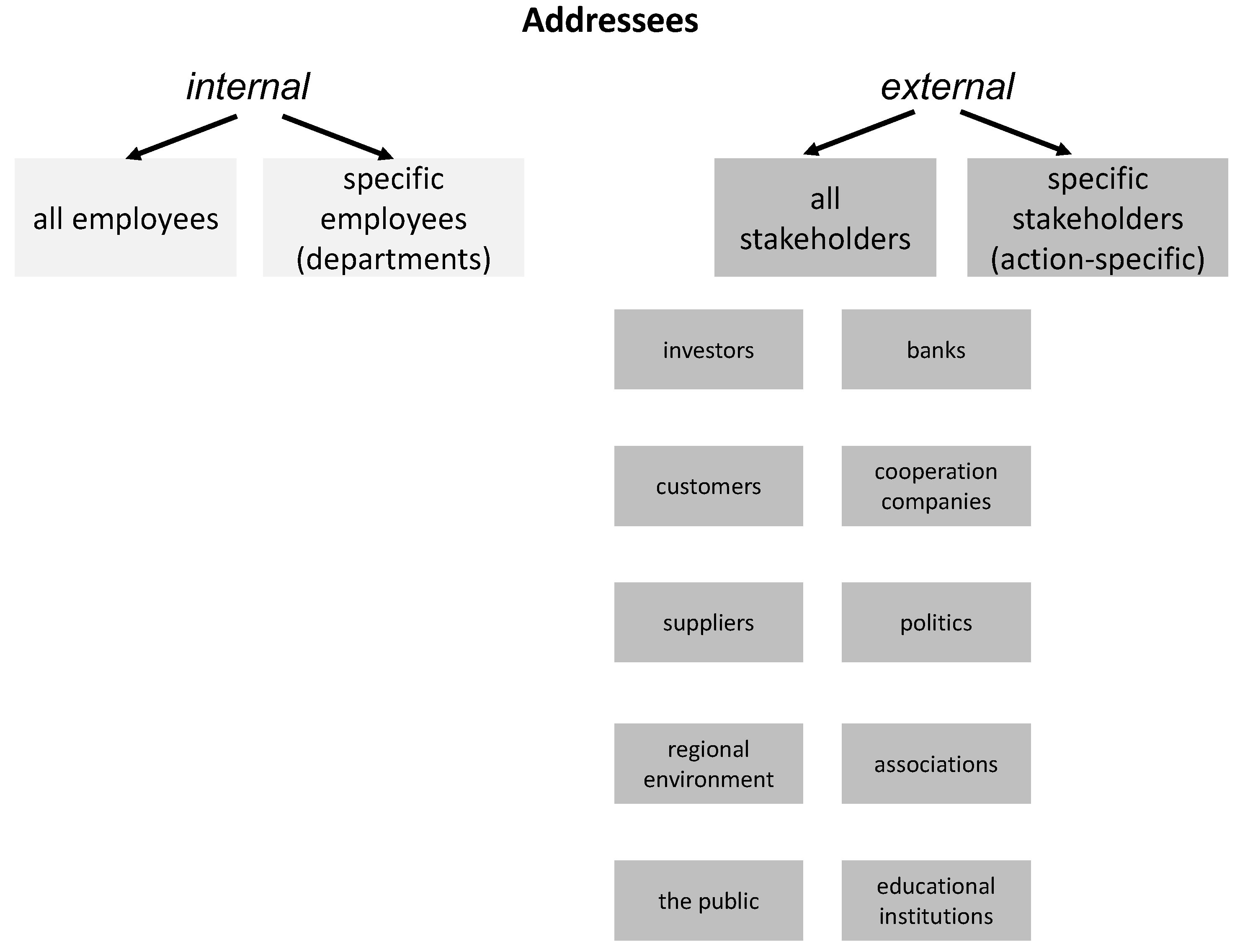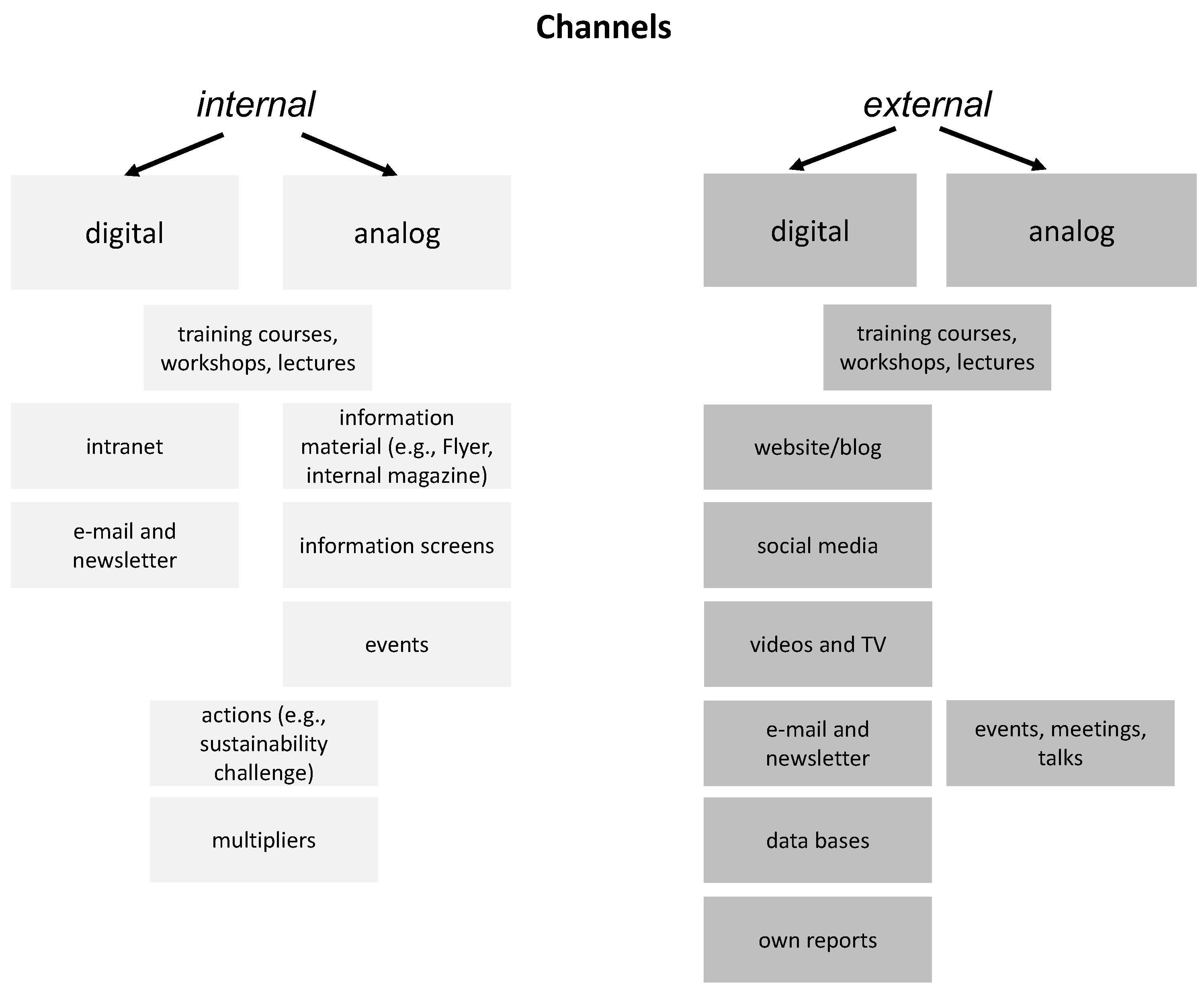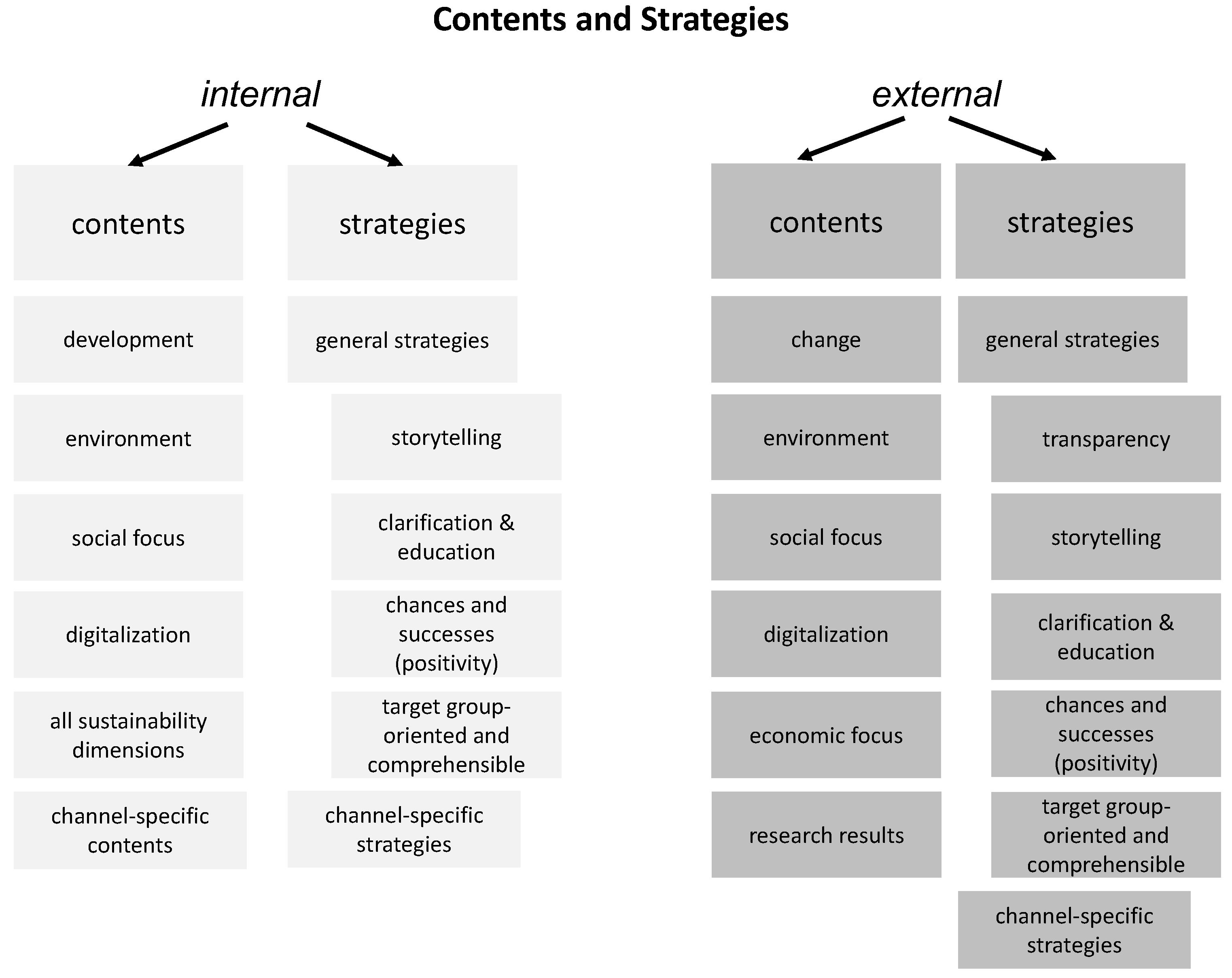Thinking Out Loud? Internal vs. External Communication of Sustainability in Companies
Abstract
1. Introduction
2. Background
2.1. Companies and Sustainability
2.2. Internal Sustainability Communication in Companies
2.3. External Sustainability Communication in Companies
2.4. Research Gaps, Aim, and Questions
- RQ1: What is the status of sustainability in companies?
- RQ2: How is sustainability communicated?
- RQ3: What is the impact of communicating sustainability in companies and how can it be improved?
3. Materials and Methods
3.1. Study Design
3.2. Data Acquisition and Analysis
3.3. Characteristics of Participants
4. Results
4.1. Status Quo of Sustainability in Companies (RQ1)
4.1.1. Relevance of Sustainability
“I’m also a mother of two, so I see it as my responsibility to not only watch my own behavior, but also to be a role model, because of course the next generation is going to be much more aware of all this, and of course they’re going to have to live with the consequences much more.” (female, 40 years)
4.1.2. Definition of Sustainability
“As I said, everything in our company is also based on the triple bottom line, i.e., social, environmental and economic aspects. We have a sustainability mission statement that addresses various aspects.” (female, 30 years)
4.1.3. Investments in Sustainability and Strategies
“On the one hand, as far as major investments are concerned, I would also mention the certificates that we have. We have relevant sustainability certificates […] and a sustainable product certificate for furniture. These are considerable sums of money every year and the whole management is behind it, of course it has to be valid, it is checked […]. The other thing is that we have quite extensive sustainability communication. Of course, this also involves a lot of investment. Also in the sustainability report. Yes, in communication via social media, for example. And we also have large investment projects from time to time, such as a small photovoltaic system that is now being expanded. So there is a lot going on and there will be even more in the future.” (female, 30 years)
4.1.4. Goals and Communication of Goals
“We have various sustainability goals, which are also publicly available and known within the company. They are revised every few years, also based on a materiality analysis that we do. They go through various departments and are then reviewed again and again and measures are derived.” (female, 30 years)
4.1.5. Insufficient Actions
“Here, too, I would say that there is still a lot of potential. That is, yes, against the backdrop of the resources that we have available, you certainly always have to consider that not everything is possible that we would like or that I would like. But even here I would say that there is still room for improvement […] but maybe that would require more resources.” (female, 40 years)
4.2. Communication of Sustainability (RQ2)
4.2.1. Addressees of Communication
“So it’s basically for everybody, we don’t make any big distinctions.” (female, 40 years)
“As many as possible, in fact. So, of course, we try to address our consumers in a way that clearly communicates the value of sustainability. In general, we try to reach out to all the stakeholders in the industry and try to motivate them to get on board, for example by launching industry initiatives […] to show them ’hey, join in’ and share our knowledge. Stakeholders can also be politicians. For example, we are registered in the lobby register and do a lot of work there, especially when it comes to recycling processes. Stakeholder employees, stakeholder the public.” (female, 27 years)
4.2.2. Channels of Communication
“There is social media, of course, so we do a lot on LinkedIn, for example.” (female, 52 years)
“Then we have an employee magazine that comes out once a quarter.” (female, 27 years)
4.2.3. Strategies and Contents of Communication
“So, yes, the only communication that takes place via e-mail, for example, is very product-specific or supplier-specific information that I then pass on or receive. (female, 30 years)
“I think we try to be transparent with all topics and it always depends on what it is.” (male, 33 years)
“And that is why communication must of course always be tailored to the addressee of the communication.” (female, 52 years)
“So they mainly say ‘Ok, how the company is developing, what other goals it has in terms of sustainability and also what the resources are at the moment, what it is simply aiming for’.” (female, 23 years)
“So the climate issue is one that is very relevant in the perception of stakeholder employees.” (female, 52 years)
“And I would also say that digitization is a particularly important topic, especially because there is the Hospital Future Act that is currently being implemented, and that plays a very important role.” (female, 23 years)
“So a lot of external communication is about the ‘functioning circular economy’.” (female, 27 years)
“For example, if you look at the structural change activities in the region, the company is very, very committed to that.” (female, 48 years)
4.3. Impact and Potential of Improvement of Sustainability Communication (RQ3)
4.3.1. Effects of Communication
“And then you realize that the willingness of the employees is also completely different when you talk about such successes.” (male, 61 years)
“And what […] is perhaps also an effect […] is the duration of service of our employees. The average is over 15 years, which is a very long time if you compare it with other companies. And I believe that if employees didn’t identify with the company in this way, they wouldn’t stay for so long.” (female, 27 years)
“I think it’s perfectly legitimate to nudge people internally or to say ‘Hm, I personally haven’t gone far enough in some areas, there could be more to come’.” (female, 48 years)
“They know that it’s important and that it makes sense, but it also often leads to a higher workload and is therefore not always accepted positively.” (female, 30 years)
4.3.2. Potential of Improvements in Communicating Sustainability
“Because this is such an important and present topic right now, it would be kind of cool if there was more communication. Especially when you’re just starting out. That you are introduced to the topic a little bit.” (female, 23 years)
“We could have done something like this again a long time ago, but we often don’t have the time or the preparation for it.” (female, 30 years)
5. Discussion
5.1. Sustainability Communication in Companies
5.2. Comparing Characteristics of Internal and External Sustainability Communication
5.3. Discussing the Effects and Improvement Potential of Sustainability Communication
6. Conclusions
6.1. Limitations of the Empirical Approach
6.2. Outlook and Future Research
Author Contributions
Funding
Institutional Review Board Statement
Informed Consent Statement
Data Availability Statement
Acknowledgments
Conflicts of Interest
References
- IPCC. Climate Change 2023. Synthesis Report. Summary for Policymakers. IPCC Geneva Switzerland. Intergovernmental Panel on Climate Change (IPCC). Available online: https://www.ipcc.ch/report/ar6/syr (accessed on 3 May 2024).
- EEA. EEA Greenhouse Gases—Data Viewer. European Environment Agency. 2023. Available online: https://www.eea.europa.eu/data-and-maps/data/data-viewers/greenhouse-gases-viewer (accessed on 3 May 2024).
- Otto, A.; Göpfert, C.; Thieken, A.H. Are cities prepared for climate change? An analysis of adaptation readiness in 104 German cities. Mitig. Adapt. Strateg. Glob. Chang. 2021, 26, 35. [Google Scholar] [CrossRef]
- European Union. Corporate Sustainability Reporting Directive, Directive (EU) 2022/2464. European Parliament and the Council of the European Union. 2022. Available online: https://eur-lex.europa.eu/eli/dir/2022/2464/oj (accessed on 3 May 2024).
- German Federal Environment Agency. Umweltbewusstsein in Deutschland [Environmental Awareness in Germany]. German Federal Environment Agency. Available online: https://www.umweltbundesamt.de/themen/nachhaltigkeit-strategien-internationales/umweltbewusstsein-in-deutschland (accessed on 3 May 2024).
- Gill, R. Why the PR strategy of storytelling improves employee engagement and adds value to CSR: An integrated literature review. Public Relat. Rev. 2015, 41, 662–674. [Google Scholar] [CrossRef]
- Spear, S.; Roper, S. Storytelling in organisations: Supporting or subverting corporate strategy? Corp. Commun. Int. J. 2016, 21, 516–532. [Google Scholar] [CrossRef]
- Brundtland, G.H. Our Common Future World. Report of the World Commission on Environment and Development; Oxford University Press: Oxford, UK, 1987. [Google Scholar]
- Bianchi, G.; Testa, F.; Boiral, O.; Iraldo, F. Organizational learning for environmental sustainability: Internalizing lifecycle management. Organ. Environ. 2022, 35, 103–129. [Google Scholar] [CrossRef]
- Fischer, D.; Brettel, M.; Mauer, R. The three dimensions of sustainability: A delicate balancing act for entrepreneurs made more complex by stakeholder expectations. J. Bus. Ethics 2020, 163, 87–106. [Google Scholar] [CrossRef]
- Beal, B.D. Corporate Social Responsibility: Definition, Core Issues, and Recent Developments; Sage Publications: Thousand Oaks, CA, USA, 2018. [Google Scholar]
- Kraus, P.; Brtitzelmaier, B. A literature review on corporate social responsibility: Definitions, theories and recent empirical research. Int. J. Manag. Cases 2012, 14, 282–296. [Google Scholar] [CrossRef]
- Sheehy, B.; Farneti, F. Corporate social responsibility, sustainability, sustainable development and corporate sustainability: What is the difference, and does it matter? Sustainability 2012, 13, 5965. [Google Scholar] [CrossRef]
- Moravcikova, K.; Stefanikova, L.; Rypakova, M. CSR reporting as an important tool of CSR communication. Procedia Econ. Financ. 2015, 16, 332–338. [Google Scholar] [CrossRef]
- Halkos, G.E.; Nomikos, S.N. Reviewing the status of corporate social responsibility (CSR) legal framework. Manag. Environ. Qual. Int. J. 2021, 32, 700–716. [Google Scholar] [CrossRef]
- Latif, B.; Gunarathne, N.; Gaskin, J.; Ong, T.S.; Ali, M. Environmental corporate social responsibility and pro-environmental behavior: The effect of green shared vision and personal ties. Resour. Conserv. Recycl. 2022, 186, 106572. [Google Scholar] [CrossRef]
- Biswas, S.R.; Uddin, M.A.; Bhattacharjee, S.; Dey, M.; Rana, T. Ecocentric leadership and voluntary environmental behavior for promoting sustainability strategy: The role of psychological green climate. Bus. Strategy Environ. 2022, 31, 1705–1718. [Google Scholar] [CrossRef]
- Hasebrook, J.P.; Michalak, L.; Wessels, A.; Koenig, S.; Spierling, S.; Kirmsse, S. Green Behavior: Factors Influencing Behavioral Intention and Actual Environmental Behavior of Employees in the Financial Service Sector. Sustainability 2022, 14, 10814. [Google Scholar] [CrossRef]
- De Giacomo, M.R.; Bleischwitz, R. Business models for environmental sustainability: Contemporary shortcomings and some perspectives. Bus. Strategy Environ. 2020, 29, 3352–3369. [Google Scholar] [CrossRef]
- zu Knyphausen-Aufseß, D.; Kunisch, S.; Nippa, M. Zur Rolle der BWL in Zeiten großer gesellschaftlicher und ökologischer Herausforderungen. [The role of business administration in times of major social and ecological challenges]. Die Unternehm. 2021, 75, 188–197. [Google Scholar] [CrossRef]
- Koep, L. Tensions in aspirational CSR communication—A longitudinal investigation of CSR reporting. Sustainability 2017, 9, 2202. [Google Scholar] [CrossRef]
- Sievert, H.; Meißner, F.; Hetzel, E. Internal and External Aspects of Sustainability Communication. An investigation of CSR reporting and media coverage in different industries 2020–2021. In Public Relations and Sustainability, Proceedings of the 30th International Public Relations Research Symposium BledCom; Verčič, D., Tkalac, A., Sriramesh, K., Eds.; University of Ljubljana: Ljubljana, Slovenia, 2022; pp. 233–247. [Google Scholar]
- Wehmeier, S.; Schultz, F. Communication and corporate social responsibility: A storytelling perspective. In The Handbook of Communication and Corporate Social Responsibility; Wiley Online Library: Hoboken, NJ, USA, 2011; pp. 467–488. [Google Scholar]
- Birkinshaw, J.; Hamel, G.; Mol, M.J. Management innovation. Acad. Manag. Rev. 2008, 33, 825–845. [Google Scholar] [CrossRef]
- Sievert, H.; Wagner, R.; Weiler, T. Contributing via Internal Social Media towards a better CSR Communication at the Top and Throughout an Organization Theoretical Foundations and New Results from a Qualitative Case Study and an additional Quantitative Interview Survey in Germany. SSRN. 2021. Available online: https://ssrn.com/abstract=4036563 (accessed on 25 June 2024). [CrossRef]
- Wagner, R. Effektive Interne CSR-Kommunikation: Sinn Stiften und Motivieren Für eine Nachhaltige Unternehmensentwicklung, [Effective Internal CSR Communication: Creating Meaning and Motivation for Sustainable Corporate Development]; Springer: Berlin/Heidelberg, Germany, 2019. [Google Scholar]
- Kataria, A.; Kataria, A.; Garg, R. Effective Internal Communication: A Way Towards Sustainability. Int. J. Bus. Insights Transform. 2013, 6, 46. [Google Scholar]
- Schaefer, S.D.; Terlutter, R.; Diehl, S. Talking about CSR matters: Employees’ perception of and reaction to their company’s CSR communication in four different CSR domains. In Leveraged Marketing Communications; Routledge: London, UK, 2021; pp. 186–207. [Google Scholar]
- Madsen, V.T. Constructing organizational identity on internal social media: A case study of coworker communication in Jyske Bank. Int. J. Bus. Commun. 2016, 53, 200–223. [Google Scholar] [CrossRef]
- Nyagadza, B.; Kadembo, E.M.; Makasi, A. Exploring internal stakeholders’ emotional attachment & corporate brand perceptions through corporate storytelling for branding. Cogent Bus. Manag. 2020, 7, 1816254. [Google Scholar]
- Poggio, B. Deconstructing and challenging gender orders in organizations through narratives. In Handbook of Research Methods in Diversity Management, Equality and Inclusion at Work; Edward Elgar Publishing: Cheltenham, UK, 2018; pp. 430–449. [Google Scholar]
- Hall, K.R.; Harrison, D.E.; Obilo, O.O. Building positive internal and external stakeholder perceptions through CSR storytelling. J. Strateg. Mark. 2023, 31, 1317–1338. [Google Scholar] [CrossRef]
- Ihlen, Ø.; Bartlett, J.L.; May, S. Conclusions and take away points. In The Handbook of Communication and Corporate Social Responsibility; Wiley Online Library: Hoboken, NJ, USA, 2011; pp. 550–571. [Google Scholar]
- Steenkamp, H.; Rensburg, R.S. CSR on display: Using spectacles and storytelling as stakeholder engagement mechanisms. In UPSpace Institutional Repository; University of the Free State: Bloemfontein, South Africa, 2019. [Google Scholar]
- Paynter, M.; Halabi, A.K. Corporate responsibility reporting and storytelling. In The Palgrave Handbook of Corporate Social Responsibility; Springer: Berlin/Heidelberg, Germany, 2021; pp. 129–148. [Google Scholar]
- Viererbl, B.; Koch, T. The paradoxical effects of communicating CSR activities: Why CSR communication has both positive and negative effects on the perception of a company’s social responsibility. Public Relat. Rev. 2022, 48, 102134. [Google Scholar] [CrossRef]
- Kim, S.; Ferguson, M.T. Public expectations of CSR communication: What and how to communicate CSR. Public Relat. J. 2014, 8, 1–22. [Google Scholar]
- Golob, U.; Podnar, K. Exploring CSR communication patterns in social media: A review of current research. In Communicating Corporate Social Responsibility in the Digital Era; Routledge: London, UK, 2017; pp. 69–84. [Google Scholar]
- Gomez, L.M. Social media concepts for effective CSR online communication. In Communicating Corporate Social Responsibility in the Digital Era; Routledge: London, UK, 2017; pp. 193–215. [Google Scholar]
- Gomez, L.M. The state of social media research in CSR communication. In The Palgrave Handbook of Corporate Social Responsibility; Springer: Berlin/Heidelberg, Germany, 2021; pp. 577–598. [Google Scholar]
- Dahl, T.; Fløttum, K. Climate change as a corporate strategy issue: A discourse analysis of three climate reports from the energy sector. Corp. Commun. Int. J. 2019, 24, 499–514. [Google Scholar] [CrossRef]
- O’Dochartaigh, A. No more fairytales: A quest for alternative narratives of sustainable business. Account. Audit. Account. J. 2019, 32, 1384–1413. [Google Scholar] [CrossRef]
- Breitbarth, T.; Harris, P.; Insch, A. Pictures at an exhibition revisited: Reflections on a typology of images used in the construction of corporate social responsibility and sustainability in non-financial corporate reporting. J. Public Aff. 2010, 10, 238–257. [Google Scholar] [CrossRef]
- Jones, P.; Comfort, D. Storytelling and corporate social responsibility reporting: A case study of leading UK retailers. Eur. J. Sustain. Dev. Res. 2018, 2, 1–11. [Google Scholar] [CrossRef] [PubMed]
- Dion, M. Corporate citizenship, social responsibility, and sustainability reports as “would-be” narratives. Humanist. Manag. J. 2017, 2, 83–102. [Google Scholar] [CrossRef]
- Mayring, P. Qualitative content analysis. Companion Qual. Res. 2004, 1, 159–176. [Google Scholar]




Disclaimer/Publisher’s Note: The statements, opinions and data contained in all publications are solely those of the individual author(s) and contributor(s) and not of MDPI and/or the editor(s). MDPI and/or the editor(s) disclaim responsibility for any injury to people or property resulting from any ideas, methods, instructions or products referred to in the content. |
© 2024 by the authors. Licensee MDPI, Basel, Switzerland. This article is an open access article distributed under the terms and conditions of the Creative Commons Attribution (CC BY) license (https://creativecommons.org/licenses/by/4.0/).
Share and Cite
Offermann, J.; Rohowsky, A.; Ziefle, M. Thinking Out Loud? Internal vs. External Communication of Sustainability in Companies. Sustainability 2024, 16, 5416. https://doi.org/10.3390/su16135416
Offermann J, Rohowsky A, Ziefle M. Thinking Out Loud? Internal vs. External Communication of Sustainability in Companies. Sustainability. 2024; 16(13):5416. https://doi.org/10.3390/su16135416
Chicago/Turabian StyleOffermann, Julia, Anna Rohowsky, and Martina Ziefle. 2024. "Thinking Out Loud? Internal vs. External Communication of Sustainability in Companies" Sustainability 16, no. 13: 5416. https://doi.org/10.3390/su16135416
APA StyleOffermann, J., Rohowsky, A., & Ziefle, M. (2024). Thinking Out Loud? Internal vs. External Communication of Sustainability in Companies. Sustainability, 16(13), 5416. https://doi.org/10.3390/su16135416







